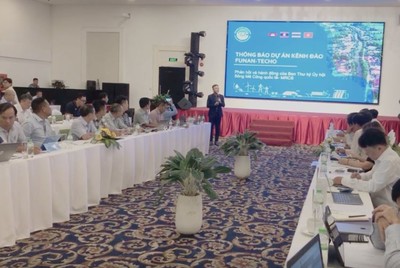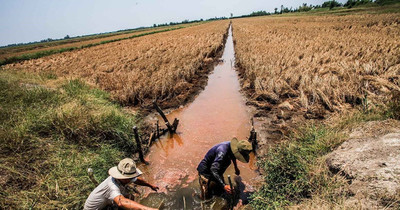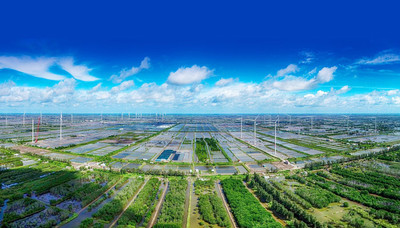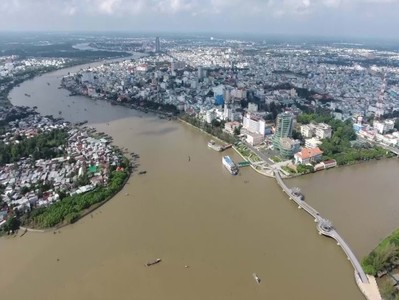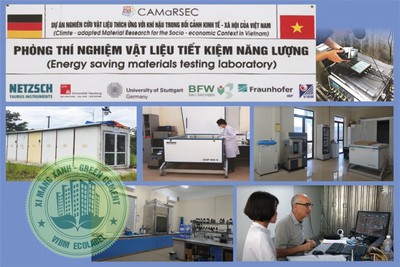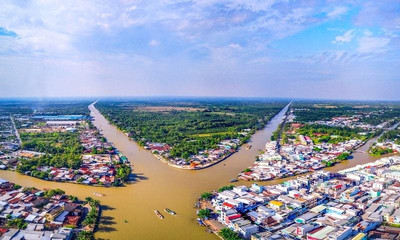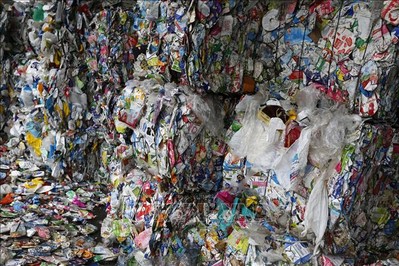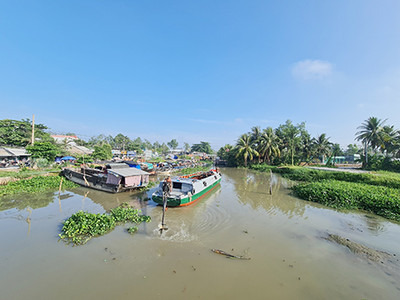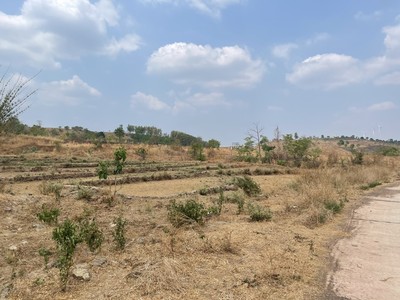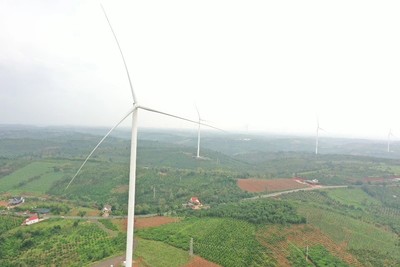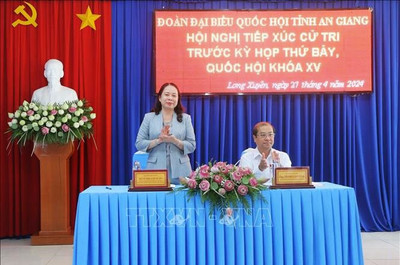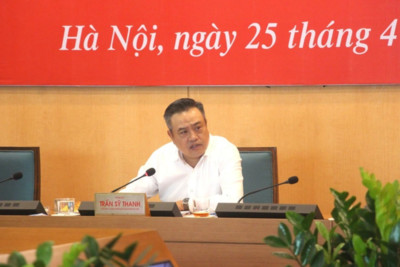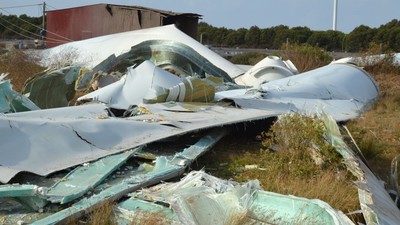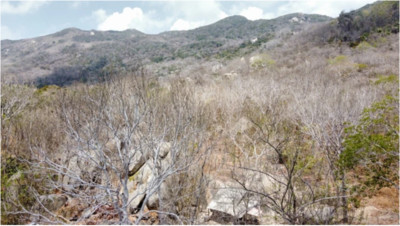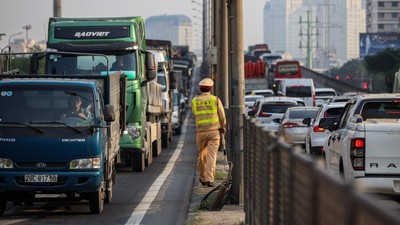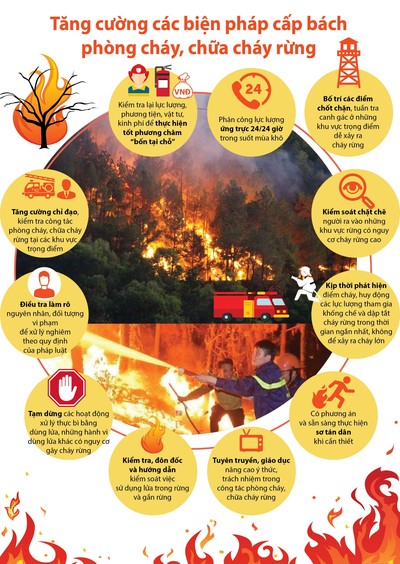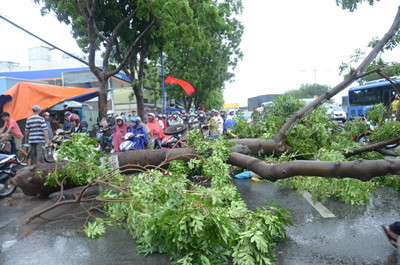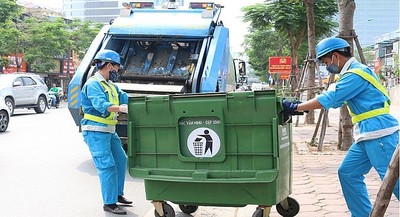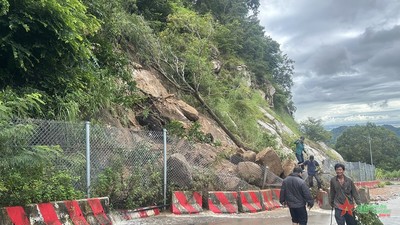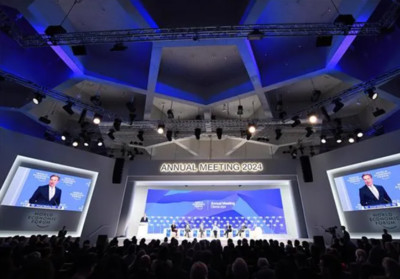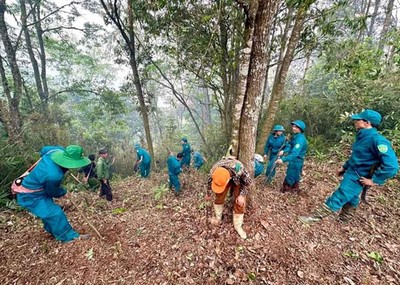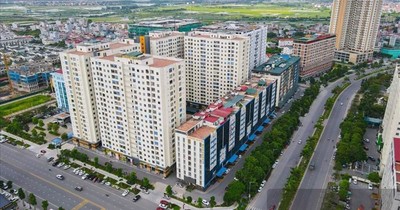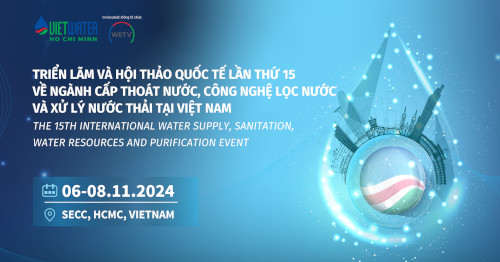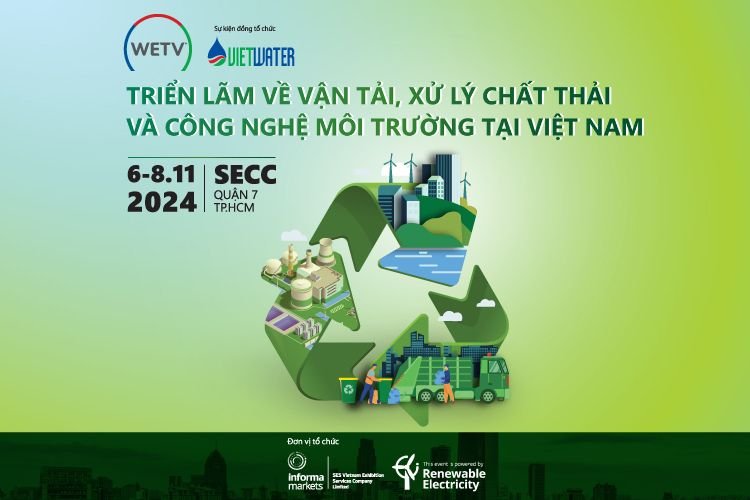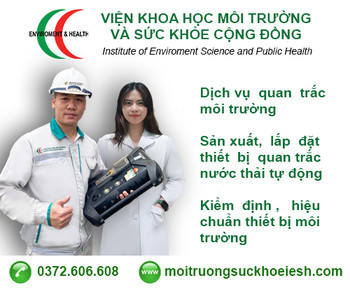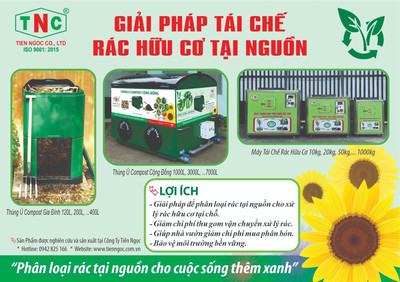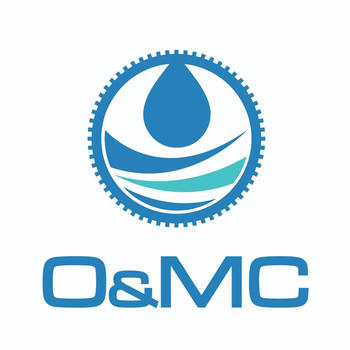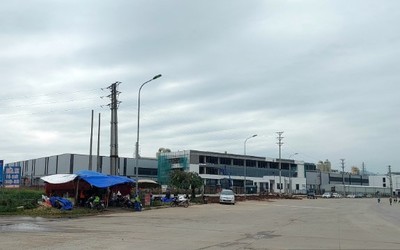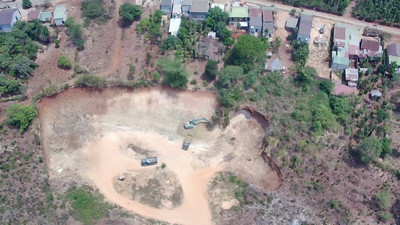Công bố quốc tế lĩnh vực môi trường số 05-2024
Ban biên tập Chuyên trang Quản lý Môi trường, Tạp chí Môi trường và Đô thị Việt Nam trân trọng giới thiệu tới quý độc giả Công bố quốc tế lĩnh vực môi trường số 05-2024.
The Environmental Management Special Section is pleased to present to our valued readers the International Environmental Bulletin No. 05-2023, featuring the following key topics:
Về quản lý môi trường
- Biến đổi khí hậu nhanh chóng làm thay đổi môi trường và sản xuất sinh học của Ấn Độ Dương.
- Gánh nặng toàn cầu, khu vực và quốc gia về bệnh tim thiếu máu cục bộ do PM2.5 trong môi trường xung quanh từ năm 1990 đến năm 2019: Phân tích về gánh nặng bệnh tật toàn cầu năm 2019.
- Đánh giá bước xử lý toàn diện lần thứ 4 để loại bỏ chất ô nhiễm vi mô tại Thụy Điển: Combo bộ lọc cát và GAC.
- Gánh nặng bệnh tim mạch do ô nhiễm PM2.5 trong môi trường xung quanh từ năm 1990 đến năm 2019: Phân tích có hệ thống về gánh nặng bệnh tật toàn cầu năm 2019.
- Ảnh hưởng của ô nhiễm không khí xung quanh đến việc nhập viện vì bệnh hô hấp ở trẻ em Hà Nội giai đoạn 2007–2019.
- Đánh giá bước xử lý toàn diện lần thứ 4 để loại bỏ chất ô nhiễm vi mô tại Thụy Điển: Combo bộ lọc cát và GAC.
- Hướng tới quản lý bền vững về môi trường: Đánh giá về việc tạo ra, phân hủy và tái chế chất thải khẩu trang bằng polypropylen.
- Blockchain có thể giúp hạn chế việc "tẩy xanh” trong lĩnh vực tài chính xanh không? Dựa trên lý thuyết trò chơi tiến hóa ba bên.
- Chiến lược quản lý và loại bỏ vi nhựa cho các nhà máy xử lý nước thải.
Về môi trường đô thị
- Tổng hợp cordierite sử dụng tro bay từ quá trình đốt chất thải rắn đô thị làm phụ gia để tăng cường quá trình oxy hóa xúc tác các hợp chất hữu cơ dễ bay hơi.
- Hạt vi nhựa có mặt khắp nơi và ngày càng gia tăng trong đất của khu đô thị rộng lớn ở Phoenix (Arizona).
- Kiểm kê phát thải và tác động đến chất lượng không khí của thiết bị xây dựng ngoài đường ở các giai đoạn phát thải khác nhau.
- Một nghiên cứu ở nhiều thành phố về chất lượng không khí trong nhà ở nhà ở thu nhập thấp xanh và không xanh.
- Ảnh hưởng của độ axit sol khí và phối tử hữu cơ đến độ hòa tan kim loại chuyển tiếp và khả năng oxy hóa của vật chất hạt mịn trong môi trường đô thị.
- Một nghiên cứu ở nhiều thành phố về chất lượng không khí trong nhà ở nhà ở thu nhập thấp xanh và không xanh.
- Ứng dụng chiến lược dựa trên LSTM để dự báo ngắn hạn PM2.5 tại thành phố.
- Mối quan hệ giữa sự gần gũi và đặc điểm của không gian xanh với hoạt động thể chất và sức khỏe: Phân tích độ nhạy đa chiều ở bốn thành phố Châu Âu.
- Tiêu chuẩn về hiệu quả kiểm soát VOC từ thực vật đối với chất lượng không khí trong nhà: Trường hợp bức tường xanh trong khuôn viên Smith tại Đại học Harvard.
- Quy định môi trường và vị trí đô thị trong mạng lưới chuyển giao ô nhiễm liên đô thị: Góc nhìn về phân tích mạng lưới di dời các doanh nghiệp gây ô nhiễm nặng.
Về môi trường khu công nghiệp
- Nguồn và kiểm soát khí nhà kính và kim loại nặng trong nước mỏ: Di sản khí hậu tiếp tục.
- Tính bền vững của các nhà máy khí sinh học thương mại quy mô lớn ở Nepal.
- Điện khí hóa các nhà máy lọc dầu thông qua quy hoạch lý thuyết đồ thị đa thời kỳ đa mục tiêu: Nghiên cứu trường hợp đơn vị chưng cất dầu thô.
- Đánh giá không gian và thời gian và mô phỏng kịch bản về tiềm năng rủi ro của các khu công nghiệp ở quy mô khu vực.
- Số hóa có thể làm giảm ô nhiễm công nghiệp? Vai trò của đầu tư môi trường và đổi mới xanh.
- Thực hành khử cacbon trong chuỗi cung ứng dệt may: Hướng tới khung khái niệm tích hợp.
- BIM trong quản lý chất thải xây dựng: Một mô hình khái niệm dựa trên tiêu chuẩn các lớp nền tảng công nghiệp.
- Phân phối và vận chuyển các chất gây ô nhiễm trong đất thông qua các quá trình khai thác mỏ cũng như đánh giá tác động môi trường và nguy cơ sức khỏe của nó: Đánh giá các giải pháp tiềm năng.
- Khử cacbon trong hệ thống năng lượng châu Âu khi không có khí đốt của Nga: Sự phát triển về hấp thụ hydro và thu giữ carbon trong các lĩnh vực điện, nhiệt và công nghiệp.
- Loại bỏ hiệu quả cao các kim loại nặng khỏi nước thải công nghiệp mô phỏng thông qua quá trình hấp phụ sử dụng vật liệu tổng hợp carboxymethyl-chitosan.
- Nghiên cứu cơ chế lý thuyết về các thành phần nước thải công nghiệp giấy với quá trình tạo ra các gốc tự do ở pha khí và pha nước.
- Rào cản thương mại bất cân xứng và lượng khí thải CO2 trong ngành sử dụng nhiều carbon.

Xin trân trọng giới thiệu!
The Environmental Management Special Section is pleased to present to our valued readers the International Environmental Bulletin No. 05-2023, featuring the following key topics:
ENVIRONMENTAL MANAGEMENT / QUẢN LÝ MÔI TRƯỜNG
1. Rapid climate change alters the environment and biological production of the Indian Ocean
Science of The Total Environment, Volume 906, 1 January 2024, 167342
Abstract
We synthesize and review the impacts of climate change on the physical, chemical, and biological environments of the Indian Ocean and discuss mitigating actions and knowledge gaps. The most recent climate scenarios identify with high certainty that the Indian Ocean (IO) is experiencing one of the fastest surface warming among the world's oceans. The area of surface waters of >28 °C (IO Warm Pool) has significantly increased during 1982–2021 by expanding into the northern-central basins. A significant decrease in pH and aragonite (building blocks of calcified organisms) levels in the IO was observed from 1981–2020 due to an increase in atmospheric CO2 concentrations. There are also signals of decreasing trends in primary productivity in the north, likely related to enhanced stratification and nutrient depletion. Further, the rapid warming of the IO will manifest more extreme weather conditions along its adjacent continents and oceans, including marine heat waves that are likely to reshape biodiversity.
However, the impact of climate change beyond the unprecedented warming, increase in marine heat waves, expansion of the IO Warm Pool, and decrease in pH, remains uncertain for many other key variables in the IO including changes in salinity, oxygen, and net primary production. Understanding the response of these physical, chemical, and biological variables to climate change is vital to project future changes in regional fisheries and identify mitigation actions. We accordingly conclude by identifying knowledge gaps and recommending directions for sustainable fisheries and climate impact studies.
2. Global, regional, and national burden of ischemic heart disease attributable to ambient PM2.5 from 1990 to 2019: An analysis for the global burden of disease study 2019
Environmental Research, Volume 241, 15 January 2024, 117635
Abstract
Information on the spatio-temporal patterns of the burden of ischemic heart disease (IHD) caused by ambient ambient fine particulate matter (PM2.5) in the global level is needed to prioritize the control of ambient air pollution and prevent the burden of IHD. The Global Burden of Disease Study (GBD) 2019 provides data on IHD attributable to ambient PM2.5. The IHD burden and mortality attributable to ambient PM2.5 were analyzed by year, age, gender, socio-demographic index (SDI) level, geographical region and country. Estimated annual percentage change (EAPC) was calculated to estimate the temporal trends of age-standardized mortality rate (ASMR) and age-standardized disability-adjusted life years rate (ASDR) from 1990 to 2019. Globally, the ASMR and ASDR for ambient PM2.5-related IHD tended to level off generally, with EAPC of −0.03 (95% CI: −0.06, 0.12) and 0.3 (95% CI: 0.22, 0.37), respectively. In the past 30 years, there were obvious differences in the trend of burden change among different regions. A highest increased burden was estimated in low-middle SDI region (EAPC of ASMR: 3.73 [95% CI: 3.56, 3.9], EAPC of ASDR: 3.83 [95% CI: 3.64, 4.02]).
In contrast, the burden in high SDI region (EAPC of ASMR: −4.48 [95% CI: −4.6, −4.35], EAPC of ASDR: −3.98 [95% CI: −4.12, −3.85]) has declined most significantly. Moreover, this burden was higher among men and older populations. EAPCs of the ASMR (R = −0.776, p < 0.001) and ASDR (R = −0.781, p < 0.001) of this burden had significant negative correlations with the countries’ SDI level. In summary, although trends in the global burden of IHD attributable to ambient PM2.5 are stabilizing, but this burden has shifted from high SDI countries to middle and low SDI countries, especially among men and elderly populations. To reduce this burden, the air pollution management prevention need to be further strengthened, especially among males, older populations, and middle and low SDI countries.
3. Carbon feasibility of terminating plastic waste leakage by landfill mining: A case study based on practical projects in China
Science of The Total Environment, Volume 906, 1 January 2024, 167461
Abstract
Over 900 million tons (Mt) of plastic waste (PW) are disposed in Chinese landfills, posing a permanent risk of migration through environmental media. Landfill mining has emerged as a promising solution to this problem but requires incineration and a substantial energy supply for the excavation, sorting and recycling processes, which themselves exert environmental impacts, particularly on climate change. Based on the life cycle assessment of pilot-scale demonstration projects, this study investigates the carbon feasibility of landfill mining followed by several PW treatments to quantify whether terminating PW leakage from landfills will produce unaffordable greenhouse gas emissions in the drive towards carbon neutrality. The changing trend of the carbon feasibility was deduced considering the decarbonization scenarios of electricity sector and petrochemical industries.
When all the sorted PW is treated by incineration with power generation, the climate-change impact of mining is 134.10 kg CO2-eq per ton of aged refuse, projected to increase by 100.47 % in 2050. To completely eliminate the PW in Chinese landfills, the incineration pathway would generate a minimum of 2457.66 Mt CO2-eq emissions, equivalent to 17.69 % of the 2020 emissions in China by carbon flow analysis. In all scenarios, the most carbon-feasible solution was mechanical recycling of high-quality PW combined with chemical recycling of low-quality PW, although the industrial application of chemical recycling technologies remains uncertain. This study provides stakeholders with systematic guidance for balancing the trade-off between PW management and climate action.
4. Identifying regional eco-environment quality and its influencing factors: A case study of an ecological civilization pilot zone in China
Journal of Cleaner Production, Volume 435, 5 January 2024, 140308
Abstract
Jiangxi Province is one of the first ecological civilization pilot zones (ECPZ) in China. The assessment of eco-environment quality (EQ) assessment and its future trends are of great significance to the maintenance of ecological security in Jiangxi Province and the construction of other pilot zones in China. Here, we propose an extended remote sensing ecological index (ERSEI), and then analyze its spatiotemporal distribution features and trends; we combine this with the optimal parameters-based geographical detector (OPGD) model to quantify the influencing factors, and further explore the future trends and prospects of the ERSEI.
Our results show that: (1) Compared with the remote sensing ecological index (RSEI), the ERSEI can more effectively reflect regional differences in EQ. (2) Areas with an excellent ERSEI are mainly located in the important ecological barrier areas of Jiangxi Province, whereas areas with poor or worst ERSEI values correspond to the spatial distribution of the Nanchang metropolitan circle, town clusters, and urban development axes. (3) The ERSEI in Jiangxi Province improved in 72.50% of the study area from 2001 to 2021. (4) Slope, population density, and elevation are the key factors affecting the ERSEI, with the interaction between slope and population density explaining 79.9% of the variance in the ERSEI spatial distribution. (5) The areas predicted to see future rises and falls in the ERSEI in Jiangxi Province at 56.55 × 103 and 96.24 × 103 km2, respectively. These research results can provide support for Jiangxi Province to achieve sustainable development and ecological civilization construction, while also providing an ERSEI that effectively identifies regional differences and acts as a new reference to further EQ research.
5. Assessment of full-scale 4th treatment step for micro pollutant removal in Sweden: Sand and GAC filter combo
Science of The Total Environment, Volume 906, 1 January 2024, 167424
Abstract
This study focuses on the 4th treatment step in Degeberga WWTP treatment plant, the first full scale GAC filter in Sweden installed in April 2020 for removal of micropollutants. The two GAC filters, containing two different carbon types, has operated flawlessly for three years (30,000 bed volumes) without requiring backwashing. The results indicate that the sand filter provides effective protection to the carbon filters, preventing solids from reaching the carbon and reducing the growth of organic matter. Additionally substantial biodegradation was observed for several substances.
During the first year of operation, the two filters (at 8500 and 5700 bed volumes respectively) achieved >98 % removal of 24 substances. By the end of the second year (at 19,000 and 12,600 bed volumes respectively), fluconazole and sulfamethoxazole broke through completely, and the number of compounds below 80 % removal increased. The average removal of micro pollutants decreased over time. Compounds with positive charges generally exhibited higher adsorption capacities, while negatively charged compounds had lower removals. On average the investigated 24 compounds was removed by 89 % in the 4th treatment step over three years. The study suggests that biodegradation may contribute to the removal of some micropollutants in GAC filters, similar to observations made in the sand filter.
Both Swiss and suggested EU regulations aim for at least an 80 % removal in micropollutant concentration. The study evaluated the performance of the filters based on this guideline and the presented technique is after a total of eight years of investigation and evaluation a proven performer.
Overall, the 4th treatment combination of sand and GAC filters in WWTPs has shown promising results in removing organic micropollutants, addressing the need for efficient treatment strategies targeting these emerging pollutants. Degeberga WWTP serves as an example of successful implementation of advanced treatment for improving water quality and protecting human and aquatic health.
6. Cardiovascular diseases burden attributable to ambient PM2.5 pollution from 1990 to 2019: A systematic analysis for the global burden of disease study 2019
Environmental Research, Volume 241, 15 January 2024, 117678
Abstract
Background
Ambient PM2.5 pollution (APMP2.5) was the leading environmental risk factor for cardiovascular diseases (CVDs) worldwide. An up-to-date comprehensive study is needed to provide global epidemiological patterns.
Methods
Detailed data on CVDs burden attributable to APMP2.5 were obtained from the Global Burden of Disease Study (GBD) 2019. We calculated the estimated annual percentage change (EAPC) to assess temporal trends in age-standardized rates of deaths and disability-adjusted life years (DALYs) over 30 years.
Results
Globally, CVDs attributable to APMP2.5 resulted in 2.48 million deaths and 60.91 million DALYs, with an increase of 122%, respectively from 1990 to 2019. In general, men suffered markedly higher burden than women, but the gap will likely turn narrow. As for age distribution, CVDs deaths and DALYs attributable to APMP2.5 mainly occurred in the elder group (>70 years). Low- and middle-income regions endured the higher CVDs burden due to the higher exposure to APMP2.5, and the gap may potentially expand further compared with high-income regions. For regions, the highest age-standardized rates of APMP2.5-related CVDs deaths and DALYs were observed mainly in Central Asia, while the lowest was observed in Australasia. At the national level, countries with the largest ASDR decline were clustered in western Europe, while Equatorial Guinea, Timor-Leste and Bhutan exhibited relatively rapid increases over this period.
Conclusions
The global CVDs burden attributable to APMP2.5 has contributed to the heterogeneity of spatial and temporal distribution. APMP2.5-related CVDs deaths have largely shifted from higher SDI regions to those with a lower SDI. Globally, APMP2.5-attributable CVDs pose a significant threat to public health and diseases burden has increased over time, particularly in male, old-aged populations. The governments and health systems should take measures to reduce air pollution to impede this rising trend.
7. 1 km monthly precipitation and temperatures dataset for China from 1952 to 2019 based on new baseline climatology surfaces
Science of The Total Environment, Volume 906, 1 January 2024, 167613
Abstract
Long-term climate data and high-quality baseline climatology surface with high resolution are essential to investigate climate change and its effect on hydrological processes and ecosystem functioning. However, large uncertainties remain in the climate products in China owing to lacking of high-density distribution network of weather stations. Here, the thin plate spline (TPS) algorithm was used to produce new baseline climatology surfaces (ChinaClim_baseline) using >2000 freely available weather stations. Then, climatologically aided interpolation (CAI) was employed to generate a 1 km monthly precipitation and temperatures dataset for China during 1952–2019 (ChinaClim_time-series) via superimposing ChinaClim_baseline and monthly anomaly surface. Our finding showed that ChinaClim_baseline performed exceptionally well in four climatic regions, with RMSEs for precipitation and temperature element estimation of 1.276–28.439 mm and 0.310–2.040 °C, respectively. The correlations among ChinaClim_baseline and WorldClim2 and CHELSA were high, but there were clearly spatial differences. For ChinaClim_time-series, precipitation and temperature elements had average RMSEs between 7.502– 52.307 mm, and 0.461–0.939 °C for all months, respectively. In comparison to Peng's climatic surface and CHELSAcruts, R2 increased by ~7 %, RMSE and MAE dropped by ~17 % for precipitation; R2 hardly increased, while RMSE and MAE decreased by ~50 % for temperature elements. Our findings indicated that ChinaClim_baseline improved the accuracy of time-series climatic elements estimation obviously, and the satellite-driven data can greatly improve the accuracy of time-series precipitation estimation, but not the accuracy of time-series temperature estimation. Overall, ChinaClim_baseline as an excellent baseline climatology surface can be used for obtaining high-quality and long-term climate datasets from past to future. Meantime, ChinaClim_time-series of 1 km spatial resolution is appropriate for investigating the spatial-temporal climate changes and their impacts on eco-environmental systems in China.
8. Effect of ambient air pollution on hospital admission for respiratory diseases in Hanoi children during 2007–2019
Environmental Research, Volume 241, 15 January 2024, 117633
Abstract
Air pollution poses a threat to children's respiratory health. This study aims to quantify the association between short-term air pollution exposure and respiratory hospital admissions among children in Hanoi, Vietnam, and estimate the population-attributable burden using local data. A case-crossover analysis was conducted based on the individual records where each case is their own control. The health data was obtained from 13 hospitals in Hanoi and air pollution data was collected from four monitoring stations from 2007 to 2019. We used conditional logistic regression to estimate Percentage Change (PC) and 95% Confidence Interval (CI) in odd of hospital admissions per 10 μg/m3 increase in daily average particulate matter (e.g. PM1, PM2.5, PM10), Sulfur Dioxide (SO2), Nitrogen Dioxide (NO2), 8-h maximum Ozone and per 1000 μg/m3 increase in daily mean of Carbon Monoxide (CO).
We also calculated the number and fraction of admissions attributed to air pollution in Hanoi by using the coefficient at lag 0. A 10 μg/m3 increase in the concentration of PM10, PM2.5, PM1, SO2, NO2, O3 8-h maximum and 1000 μg/m3 increase in CO concentration was associated with 0.6%, 1.2%, 1.4%, 0.8%, 1.6%, 0.3%, and 1.7% increase in odd of admission for all respiratory diseases among children under 16 years at lag 0–2.
All PM metrics and NO2 are associated with childhood admission for pneumonia and bronchitis. Admissions due to asthma and upper respiratory diseases are related to increments in NO2 and CO. For attributable cases, PM2.5 concentrations in Hanoi exceeding the World Health Organization Air Quality Guidelines accounted for 1619 respiratory hospital admissions in Hanoi children in 2019. Our findings show that air pollution has a detrimental impact on the respiratory health of Hanoi children and there will be important health benefits from improved air quality management planning to reduce air pollution in Vietnam.
9. Assessment of full-scale 4th treatment step for micro pollutant removal in Sweden: Sand and GAC filter combo
Science of The Total Environment, Volume 906, 1 January 2024, 167424
Abstract
This study focuses on the 4th treatment step in Degeberga WWTP treatment plant, the first full scale GAC filter in Sweden installed in April 2020 for removal of micropollutants. The two GAC filters, containing two different carbon types, has operated flawlessly for three years (30,000 bed volumes) without requiring backwashing. The results indicate that the sand filter provides effective protection to the carbon filters, preventing solids from reaching the carbon and reducing the growth of organic matter. Additionally substantial biodegradation was observed for several substances.
During the first year of operation, the two filters (at 8500 and 5700 bed volumes respectively) achieved >98 % removal of 24 substances. By the end of the second year (at 19,000 and 12,600 bed volumes respectively), fluconazole and sulfamethoxazole broke through completely, and the number of compounds below 80 % removal increased. The average removal of micro pollutants decreased over time. Compounds with positive charges generally exhibited higher adsorption capacities, while negatively charged compounds had lower removals. On average the investigated 24 compounds was removed by 89 % in the 4th treatment step over three years. The study suggests that biodegradation may contribute to the removal of some micropollutants in GAC filters, similar to observations made in the sand filter.
Both Swiss and suggested EU regulations aim for at least an 80 % removal in micropollutant concentration. The study evaluated the performance of the filters based on this guideline and the presented technique is after a total of eight years of investigation and evaluation a proven performer.
Overall, the 4th treatment combination of sand and GAC filters in WWTPs has shown promising results in removing organic micropollutants, addressing the need for efficient treatment strategies targeting these emerging pollutants. Degeberga WWTP serves as an example of successful implementation of advanced treatment for improving water quality and protecting human and aquatic health.
10. Environmental insurance and green productivity: A firm-level evidence from China
Journal of Cleaner Production, Volume 435, 5 January 2024, 140482
Abstract
Green transformation is currently a major challenge for both developed and developing economies, while the role of environmental insurance (EI) in green productivity in developing economies remains unclear. Using firm-level data from Chinese A-shape listed companies, this study investigates the relationship between EI on green total factor productivity (GTFP) along the period 2010–2019. To do so, a slack-based measurement model integrated with Global Malmquist-Luenberger approach (SBM-GML) is applied in GTFP calculation, and then a time-varying difference-in-difference (DID) setup is employed for empirical analysis, as well as its combination with propensity score matching method (PSM-DID) to overcome the sample self-selection bias.
We find that EI significantly promotes firm's GTFP by about 0.22 units, which is mainly driven by the improvement of technical efficiency rather than technological progress. Further analysis exploring channels suggests that EI promotes GTFP by alleviating financing constraints and stimulating green innovation. However, the heterogeneity analysis shows that both financing constraint mechanism and technological innovation mechanism are mainly observed in heavily polluting and non-state-owned enterprises (non-SOEs). Our findings provide a new insight for policy-makers that utilizing environmental insurance can promote green productivity, but which should be focused more on those enterprises who are difficult to absorb external financing and technological innovation resources.
11. Drivers and impacts of decreasing concentrations of atmospheric volatile organic compounds (VOCs) in Beijing during 2016–2020
Science of The Total Environment, Volume 906, 1 January 2024, 167847
Abstract
China has implemented various policies and measures for controlling air pollutants. However, our knowledge of the long-term trends in ambient volatile organic compounds (VOCs) after the implementation of these action plans in China remains limited. To address this, we conducted a five-year analysis (2016–2020) of VOC compositions and concentrations in Beijing. The annual VOC concentration decreased from 44.0 ± 28.8 to 26.2 ± 16.4 ppbv, with alkanes being the most prevalent group.
The annual average concentrations of alkenes, alkynes, and aromatics have experienced a significant decrease of over 50 %. Seasonal variations indicated higher VOC concentrations in winter and autumn, with more significant reductions observed in winter and autumn. The impact of meteorological conditions caused variations in VOC reductions during the Chinese Spring Festival.
Satellite-based measurements of formaldehyde (HCHO) columns confirmed the reduction of VOC emissions during the Coronavirus (COVID-19) lockdown. The normalized annual average VOC concentration decreased by 2.9 ppbv yr−1 from 2016 to 2020, and emission reduction contributed to 58.8 % of VOC reduction from 2016 to 2020 after meteorological normalization, indicating the effectiveness of implemented control measures. Based on receptor model, vehicle emissions and industrial sources were identified as the largest contributors to VOC concentrations.
Vehicle emissions, liquefied petroleum gas/natural gas (LPG/NG) use, and coal combustion were major drivers of VOC reduction. Potential source region analysis revealed that air masses transported from northwestern and southern regions significantly contributed to VOC concentrations in Beijing. The range of source regions shrunk in both northwestern and southern regions with the reduction in VOC concentrations. The annual variations of ozone formation potential indicated a significant decrease in VOC reactivities through emission control. These results could provide insights into future emission control and coordinated efforts to improve PM2.5 and ozone levels in China.
12. Does green finance reduce environmental degradation? The role of green innovation, environmental tax, and geopolitical risk in China
Journal of Cleaner Production, Volume 435, 5 January 2024, 140353
Abstract
In the last few decades, China has faced the pressing effects of climate change due to its rapid progress in industrialization and economic expansion. China has taken the lead in developing aggressive plans to reduce environmental degradation. Considering this, several studies conclude that green finance, green innovation, and environmental taxation stand out as the most efficacious strategies for reducing environmental degradation. Also, geopolitical concerns can make it difficult to implement plans, particularly when there is political unrest, hostilities, or hostility between countries.
Therefore, this work explores the influence of green finance, green innovation, environmental tax, and geopolitical risk to mitigate environmental degradation in China. This research employed a novel dynamic ARDL simulation model for long-run association, KRLS for robustness check, and frequency domain causality for checking casual relationships from 1990 to 2020. The findings indicated that green finance, green innovation, and environmental tax mitigate the consumption and production-based carbon emissions, while geopolitical risk has adverse implications for environmental sustainability. The frequency domain causality test findings suggested that green finance, green innovation, environmental tax, and geopolitical risk have long-term casual associations in both models. These findings provide specific policy suggestions to assist China in reducing environmental deterioration and achieving the SDGs.
13. Towards environmentally sustainable management: A review on the generation, degradation, and recycling of polypropylene face mask waste
Journal of Hazardous Materials, Volume 461, 5 January 2024, 132566
Abstract
There has been a considerable increase in the use of face masks in the past years. Managing face mask waste has become a global concern, as the current waste management system is insufficient to deal with such a large quantity of solid waste. The drastic increase in quantity, along with the material's inability to degrade plastic components such as polypropylene, has led to a large accumulation of plastic waste, causing a series of environmental and ecological challenges.
In addition, the growing use also imposes pressure on waste management methods such as landfill and incineration, raising concerns about high energy consumption, low value-added utilization, and the release of additional pollutants during the process. This article initially reviews the impact of mask-related plastic waste generation and degradation behavior in the natural environment. It then provides an overview of various recently developed methods for recycling face mask plastic waste. The article also offers forward-looking strategies and recommendations on face mask plastic waste management. The review aims to provide guidance on harnessing the complexities of mask waste and other medical plastic pollution issues, as well as improving the current waste management system’s deficiencies and inefficiencies in tackling the growing plastic waste problem.
14. Can blockchain help curb "greenwashing” in green finance? - Based on tripartite evolutionary game theory
Journal of Cleaner Production, Volume 435, 5 January 2024, 140447
Abstract
To encourage enterprises to take green innovation, the Chinese government has been promoting the development of green finance. However, it has brought about the risk of "greenwashing”. This article analyzes "greenwashing” from the perspective of government intervention, focusing on the stakeholder theory and institutional theory that influence the decision-making of participants in green finance, constructing a three-party evolutionary game model for enterprises, green financial institutions, and local governments.
By comparing the stable strategy changes before and after the introduction of blockchain technology, the mechanism of blockchain in addressing the "greenwashing” risk in green finance is discussed. The study shows that: first, government regulation plays a crucial role in stimulating enterprises to engage in green innovation and encouraging green financial institutions to provide financial services; Second, before the application of blockchain technology, low-intensity regulation cannot curb the "greenwashing” of enterprises and fails to stimulate them to engage in green innovation. However, after applying blockchain technology, even under low-intensity regulation, enterprises will actively engage in green innovation under the reputation mechanism constructed in the architecture of a consortium chain. This work provides a theoretical framework and guidance for subsequent scholars to conduct quantitative research on the resolution of "greenwashing” in green finance from a government perspective using blockchain.
15. Microplastic removal and management strategies for wastewater treatment plants
Chemosphere, Volume 347, January 2024, 140648
Abstract
Discharging microplastics into the environment with treated wastewater is becoming a major concern around the world. Wastewater treatment plants (WWTPs) release microplastics into terrestrial and aquatic habitats, mostly from textile, laundry, and cosmetic industries. Despite extensive research on microplastics in the environment, their removal, and WWTP management strategies, highlighting their environmental effects, little is known about microplastics' fate and behaviour during various treatment processes. Microplastics interact with treatment technologies differently due to their diverse physical and chemical characteristics, resulting in varying removal efficiency.
Microplastics removed from WWTPs may accumulate in soil and harm terrestrial ecosystems. Few studies have examined the cost, energy use, and trade-offs of large-scale implementation of modern treatment methods for the removal of microplastics. To safeguard aquatic and terrestrial habitats from microplastics' contamination, focused and efficient management techniques must bridge these knowledge gaps. This review summarizes microplastic detection, collection, removal and management strategies. A compilation of treatment process studies on microplastics’ removal efficiency and their destiny and transit paths shows recent improvement. Bioremediation, membrane bioreactor (MBR), electrocoagulation, sol-gel technique, flotation, enhanced filtering, and AOPs are evaluated for microplastic removal. The fate and behaviour of microplastics in WWTPs suggest they may be secondary suppliers of microplastics to receiving ecosystems. Innovative microplastic removal strategies and technologies such as nanoparticles, microorganism-based remediation, and tertiary treatment raise issues.
These new WWTP technologies are examined for feasibility, limitations, and implementation issues. Pretreatment modifies microplastic size, adsorption potential, and surface morphology to remove microplastics from WWTPs. Membrane bioreactors (MBR) can remove 99.9% of microplastics more efficiently than other approaches. MBR systems require membrane cleaning and fouling control, which raises operational and capital costs. To reduce MPs, plastic alternatives and strict controls, including microplastic waste transformation, should be prioritized. Microplastics must be controlled through monitoring policy execution and awareness.
16. Journal of Cleaner Production, Assessing the progress of the mining industry towards green growth in China: A three-stage dynamic network slacks-based measure approac
Volume 435, 5 January 2024, 140478
Abstract
Promoting green growth in the mining sector requires efficient use of mineral resources, improving economic operations' quality and performance and strengthening ecological and environmental governance. Local economies face different and conflicting plans, along with potential implementation constraints, while implementing green growth initiatives. Efficiency in mining green growth is a crucial aspect to monitor the progress of China's local mining industry in the future. This paper presents a framework for three-stage network structure evaluation of mining industry's green growth efficacy.
A dynamic network model, using Slacks-Based Measure (SBM) approach, analyzes the green growth of the mining industry in 21 Chinese provinces between 2005 and 2019. The Malmquist index is used to analyze the dynamic patterns and endogeneity of mining green growth efficiency. The results show that the efficiency of most provinces exhibited a decrease before rebounding during the observation period.
Overall efficiency is strongly correlated with improved eco-performance, which is a result of green mining. There are substantial discrepancies in the pace and extent of green growth across different provinces, with a few boasting growth rates exceeding 25% annually. Eastern provinces, particularly Hubei, Fujian, and Shandong, demonstrate impressive trends and substantial potential. However, the unsatisfactory situation in the Northeast and Xinjiang regions persists. Their lack of effectiveness can be attributed to various sub-processes.
17. A framework for eco-compensation in the Yangtze River Delta region of China based on multiple policy objectives
Journal of Cleaner Production, Volume 436, 10 January 2024, 140370
Abstract
Eco-compensation plays a pivotal role in mitigating ecological service spillovers and addressing regional development imbalances. To enhance existing eco-compensation projects, a comprehensive eco-compensation framework with multiple objectives was established in the Yangtze River Delta (YRD). This framework takes into account various factors such as economic development, social welfare, ecosystem service and environmental pressure to ensure a balanced funding raising and allocation of compensation across regions.
The inter-regional eco-compensation framework employs a top-down transfer payment approach to reduce transaction costs. Notably, the case study revealed a remarkable increase in total compensation, adding up to 22.15 billion CNY in 2015 and 44.01 billion CNY in 2020, with a substantial portion raising from the hidden loss of imbalanced economic development. The number of contributing cities decreased from 23 in 2015 to 21 in 2020 whereas the number of receiving cities increased from 18 to 20 during the same period. Compared with traditional eco-compensation policies, this comprehensive eco-compensation framework demonstrates greater fairness in regional compensation, while being more attuned to fostering economic development and ecological protection.
URBAN ENVIRONMENT/ MÔI TRƯỜNG ĐÔ THỊ
1. Synthesis of cordierite using municipal solid waste incineration fly ash as one additive for enhanced catalytic oxidation of volatile organic compounds
Science of The Total Environment, Volume 906, 1 January 2024, 167420
Abstract
Municipal solid waste incineration (MSWI) fly ash is a hazardous waste, which needs various recycling in order to reach "net-zero waste”. This work aimed to synthesize cordierite using MSWI fly ash as one additive and investigate influence of the additive on properties of the cordierite. As a result, the cordierite was successfully synthesized when the additive weight ratio was <15 % and the synthesis strategy was universally feasible for 14 kinds of different MSWI fly ashes. As a heat accumulator, the cordierite attained compressive strength of 42.1 MPa, water absorption of 26 %, bulk density of 1.87 g·cm−3, and open porosity of 47 %. After five cycles of thermal impact at 1200 °C, the strength was only decreased by 15 %. These properties were comparable to a commercial cordierite. As a catalyst carrier, after loading Mn and Cu species, the cordierite removed 100 % of toluene at 250 °C. In comparison, a commercial cordierite only got a removal of 34.4 %. The enhanced activity was attributed to co-existing spinel and bytownite as well as imbedded Zn and Cu in the MSWI fly ash-added cordierite. Therefore, this work devotes to hazardous recycling, green development, and cycled economy.
2. Relevance evaluation and spatial differentiation analysis between green development and environmental footprint in China's three typical mega-urban agglomerations
Journal of Cleaner Production, Volume 436, 10 January 2024, 140644
Abstract
This study constructs a comprehensive framework for exploring the relevance between green development level and environmental footprint in three typical mega-urban agglomerations of Yangtze River Economic Belt (YREB) of China. This framework consists of the three-dimensional ecological footprint (EF3D), carbon footprint (CF), cloud model, and Environmental Kuznets Curve (EKC). Results reveal that there exist an increased EF3D and a decreased ecological carrying capacity in the YREB, with annual change rates of 4.45% and −0.46%, respectively.
According to ecological footprint depth, 24.61, 17.59, and 30.89 times of current local land area are required for supporting regional development in the YREB upstream, midstream, and downstream urban agglomerations, respectively. There is an increased tendency in CF, especially in the midstream urban agglomeration with an increased rate of 5.25%. Carbon pressure is mostly contributed by crude oil (34.47%) and raw coal (31.55%). Moreover, green development level in the YREB shows an increased tendency with an annual rate of 0.5%, and that in the downstream urban agglomeration is generally greater than other areas.
The relevance between green development level and environmental footprint is mainly inverted U-shaped or inverted N-shaped EKC types. CF in the YREB and its upstream urban agglomeration begins to decline when green development levels are 3.44 in 2020 and 3.26 in 2020, respectively. EF3D in the midstream urban agglomeration starts to fall when green development level reaches 3.36 in 2019. EF3D from cultivated land and fossil fuel land has a positive impact on the improvement of relevance. Overall, the developed framework can be applied to areas where there is a conflict between economic development and environmental protection. Furthermore, dynamic prediction of green development level and environmental footprint as well as their correlation mechanism under different scenarios are still required for enhancing environmental sustainability and promoting regional coordinated development.
3. Microplastics are ubiquitous and increasing in soil of a sprawling urban area, Phoenix (Arizona)
Science of The Total Environment, Volume 906, 1 January 2024, 167617
Abstract
Microplastics are environmental contaminants that have been extensively studied in marine and aquatic environments; terrestrial ecosystems, where most microplastics originate and have the potential to accumulate, typically receive less attention. This study aims to investigate the spatial and temporal soil concentrations of microplastics in a large desert metropolitan area, the Central Arizona–Phoenix Long-Term Ecological Research (CAP-LTER) area. Soil samples from the Ecological Survey of Central Arizona (ESCA) surveys (2005 and 2015) were leveraged to study spatial distributions and the temporal change of microplastic abundances.
The temporal soil microplastics data were supplemented by microplastics deposition fluxes in a central location within the area (Tempe, AZ) for a period of one year (Oct 5th, 2020 to Sept 22nd, 2021). Samples were processed and microplastics were counted under an optical microscope to obtain quantitative information of their distribution in soil. Results for the spatial variation of the microplastic abundances in soil samples in Phoenix and the surrounding areas of the Sonoran Desert from 2015 depict microplastics as ubiquitous and abundant in soils (122 to 1299 microplastics/kg) with no clear trends between different locations. Microplastics deposition fluxes show substantial deposition in the local area (71 to 389 microplastics/m2/day with an average deposition flux of 178 microplastics/m2/day) but the role of resuspension and redistribution by dust storms to deposition may contribute to the unclear spatial trends. Comparison between the 2005 and 2015 surveys show a systematic increase in the abundance of microplastics and a decrease in microplastics size. Micro-Raman spectroscopy identified a variety of plastics including PE, PS, PVC, PA, PES and PP. However, a majority of microplastics remained chemically unidentifiable. Polyethylene was present in 75 % of the sampling sites and was the most abundant polymer on average in all soil samples.
4. Urban green, blue spaces and their joint effect are associated with lower risk of emotional and behavior problem in children and adolescents, a large population-based study in Guangzhou, China
Environmental Research, Volume 240, Part 2, 1 January 2024, 117475
Abstract
Extensive research has been conducted on the impact of urban Green and blue spaces (GBS) on mental health. However, there is a dearth of studies examining the potential influence of GBS on Emotion and behavior problems (EBP) in youth populations. This study seeks to address this research gap by examining the association between GBS exposure and EBP in youths, utilizing a large population-based survey. Exposure indicators were derived for each participant, taking into account the 1-m resolution land coverage percentage measurements at their residential and school locations, with buffer sizes of 500m and 800m.
The study employed the parent-reported Strengths and Difficulties Questionnaire (SDQ) as a measurement to EBP. To investigate this relationship, a Poisson linear mixed-effects model with comprehensive adjustment was utilized. Stratified analyses were conducted, taking into account demographic variables, while sensitivity analyses were performed to evaluate the reliability of the findings.
The primary analysis encompassed a sample of 172,490 individuals, with an average age of 10.2 (standard deviation = 2.99), of whom 55.8% were male. Among young individuals residing within a 500-m radius of residential green spaces (GS), those in the second and third tertiles experienced a 5.0% and 7.6% decrease in the risk of developing total difficulties respectively, compared to those in the first tertile. Exposure to blue spaces (BS) around the residence yielded comparable results, with an AOR of 0.896 (95% CI: 0.866, 0.928) for the second tertile and an AOR of 0.991 (95% CI: 0.879, 0.943) for the third tertile, compared to the first tertile. The decrease in EBPs may also be linked to the joint effect of GS and BS. Young individuals were exposed to GS or BS, as well as the higher level of GS in conjunction with comparable BS, exhibited an inverse correlation with self-reported EBPs.
5. Method development and empirical research in examining the construction of China's "Zero-waste Cities”
Science of The Total Environment, Volume 906, 1 January 2024, 167345
Abstract
At the current stage, >100 cities in China are in the process of constructing "Zero-waste Cities” (ZCs). However, the absence of a unified quantitative evaluation method hinders the real-time display, assessment, and analysis of the progress and effectiveness of construction in various cities. Based on China's "Zero-waste City” (ZC) construction index system, a five-dimensional evaluation approach of transforming the city's construction index system into an evaluation index system is proposed, and an evaluation method for examining the construction of China's ZCs is developed.
Meanwhile, the obstacle analysis model is employed to identify ZC's advantages and weaknesses. Following this evaluation framework, empirical research was conducted on Shenzhen. Results showed: 1) Shenzhen's ZC scoring result increased significantly from 58.9 to 108.3 by implementing the pilot project; 2) The dimensions of Management Measure, Support Capacity, and City Characteristic had achieved or approached full scores, but the dimension of Management Level still need improvement. 3) While industrial waste management reached an excellent level and agricultural waste proved manageable, domestic waste landfill and construction waste disposal still existed challenges. This method takes into account the uniformity of evaluation methods in nationwide and the diversity of solid waste environmental issues in cities. It can achieve a quantitative assessment of the ZC construction level for all cities in China, and providing a scientific basis for the horizontal comparison of the construction effectiveness of each city.
6. A multi-city study of indoor air quality in green vs non-green low-income housing
Environmental Research, Volume 240, Part 2, 1 January 2024, 117576
Abstract
Objectives
The condition of the home is a strong predictor of exposure to environmental contaminants, with low-income households being particularly vulnerable. Therefore, improving housing standards is a priority. Housing built to "green” standards, with improved building methods and materials, has been suggested to reduce contaminants. However, evidence is limited as to which contaminants are reduced. The Green Housing Study was conducted to address this issue. The study hypothesis was that housing built using green components has lower concentrations of environmental contaminants compared to conventional housing.
Methods
A repeated-measures, 12-month cohort study was performed in three U.S. cities. Data were collected in the home at three time points throughout a year. The level of contaminants were estimated using air samples for particulate matter and black carbon, dust samples for aeroallergens and pesticides, and resident or study staff reporting evidence of mold. To investigate source(s) of PM2.5 and black carbon, multivariable models using stepwise variable selection were developed.
Results
In adjusted generalized estimating equations (GEE) models, black carbon concentration (μg/m3) (β = −0.22, 95% CI = −0.38 to −0.06, p = 0.01), permethrin (OR = 0.28, 95% CI = 0.15–0.49, p < 0.0001), and reported mold (OR = 0.29, 95% CI = 0.13–0.68, p = 0.003) were significantly lower in green homes. Cockroach antigen was also lower in green homes (OR = 0.59, 95% CI = 0.33–1.08, p = 0.09), although not statistically significant. We found that 68% of PM2.5 was explained by dwelling type and smoking and 42% of black carbon was explained by venting while cooking and use of a gas stove.
Conclusions
This study provides quantitative data suggesting benefits of incorporating green building practices on the level of numerous environmental contaminants known to be associated with health. Occupant behavior, particularly smoking, is an important contributor to indoor air pollution.
7. Emission inventory and air quality impact of non-road construction equipment in different emission stages
Science of The Total Environment, Volume 906, 1 January 2024, 167416
Abstract
Non-road construction equipment (NRCE) is an important source of air pollution, and it is crucial to fully understand the impact of NRCE on atmospheric PM2.5 and O3 pollution. However, systematic assessment of the impact of NRCE emissions on the atmosphere is lacking, especially with the latest implementation of the Stage IV Standard, and current research progress is insufficient for the development of effective control measures.
This study estimated NRCE emission inventories at different emission standard stages and their impact on the atmosphere, using the "2 + 26” cities as the case study area. The results showed that the total NRCE emissions of CO, NOx, VOC, and PM2.5 were 387, 418, 82, and 24 kt in 2015 and 319, 262, 62, and 15 kt in 2020 and are predicted to be 270, 226, 48, and 10 kt in 2025, respectively. Simulation results showed that the contributions of NRCE to NO3−, NO2, PM2.5, and O3 were 16.7 %, 18.9 %, 7.7 %, and 8.2 % in 2015 to 13.6 %, 18.4 %, 6.5 %, and 6.7 % in 2020, respectively. In both 2015 and 2020, NRCE emissions in southern cities showed greater impacts on the average concentrations in the "2 + 26” cities than those in northern cities.
The contributions of local NRCE emissions to local PM2.5 and O3 concentrations in the 28 cities ranged from 30 %–59 % and 13 %–39 %, respectively. The O3 sensitivity estimated by the HDDM illustrated that nonlinear characteristics highlighted the importance of coordinated control of NOx and VOC and can inspire development of post-processing technology and electricity substitution. The belt-like area connecting Zhengzhou to Beijing showed higher exposure concentrations of PM2.5 and O3, and the concentration exposure in urban areas was much higher than that in the rural and other areas. The environmental impact assessment of NRCE emissions can provide guidance for its management and development.
8. A multi-city study of indoor air quality in green vs non-green low-income housing
Environmental Research, Volume 240, Part 2, 1 January 2024, 117576
Abstract
Objectives
The condition of the home is a strong predictor of exposure to environmental contaminants, with low-income households being particularly vulnerable. Therefore, improving housing standards is a priority. Housing built to "green” standards, with improved building methods and materials, has been suggested to reduce contaminants. However, evidence is limited as to which contaminants are reduced. The Green Housing Study was conducted to address this issue. The study hypothesis was that housing built using green components has lower concentrations of environmental contaminants compared to conventional housing.
Methods
A repeated-measures, 12-month cohort study was performed in three U.S. cities. Data were collected in the home at three time points throughout a year. The level of contaminants were estimated using air samples for particulate matter and black carbon, dust samples for aeroallergens and pesticides, and resident or study staff reporting evidence of mold. To investigate source(s) of PM2.5 and black carbon, multivariable models using stepwise variable selection were developed.
Results
In adjusted generalized estimating equations (GEE) models, black carbon concentration (μg/m3) (β = −0.22, 95% CI = −0.38 to −0.06, p = 0.01), permethrin (OR = 0.28, 95% CI = 0.15–0.49, p < 0.0001), and reported mold (OR = 0.29, 95% CI = 0.13–0.68, p = 0.003) were significantly lower in green homes. Cockroach antigen was also lower in green homes (OR = 0.59, 95% CI = 0.33–1.08, p = 0.09), although not statistically significant. We found that 68% of PM2.5 was explained by dwelling type and smoking and 42% of black carbon was explained by venting while cooking and use of a gas stove.
Conclusions
This study provides quantitative data suggesting benefits of incorporating green building practices on the level of numerous environmental contaminants known to be associated with health. Occupant behavior, particularly smoking, is an important contributor to indoor air pollution.
9. How electric vehicles benefit urban air quality improvement: A study in Wuhan
Science of The Total Environment, Volume 906, 1 January 2024, 167584
Abstract
Urban air quality is a global concern, and while numerous studies have examined the impact of geography, climate, and urban development on air quality, few have considered the role of electric vehicles (EVs) in predictive models. Furthermore, little attention has been paid to the spatial heterogeneity of EVs. Given the rapid growth of the EV industry, it is crucial to understand the increasing significance of EVs and electric vehicle charging stations (EVCS) on air quality. This study focuses on Wuhan, a representative polycentric city, to investigate the combined effects of EVs and EVCS on air quality, alongside other urban factors.
The study employs Markov chains (MC) to process air quality data and utilizes Ordinary Least Squares (OLS) and Multiscale Geographically Weighted Regression (MGWR) for data modeling. The results highlight that incorporating EV and EVCS variables enhances the model's fit. Notably, EVCS demonstrates a pronounced influence on improving air quality in areas with high plot ratios and building densities along the north bank of the Yangtze River. The study identifies spatial variations in the geographic distribution of both EVs and EVCS, as well as the distribution of MGWR coefficients.
Three distinct regional centers in Wuhan exhibit high concentrations of EVCS per unit area. Moreover, the projected outcomes suggest that these three regions can anticipate significant improvements in air quality, with probabilities ranging from 3.93 % to 10.06 %, 4.40 % to 11.43 %, and 2.55 % to 6.52 % in achieving an Excellent Status (S1) for future air quality, under the assumption of maintaining current EV policies. This study advances our understanding of the contribution of EVs and EVCS to air quality within polycentric cities. It introduces novel research perspectives and methodologies, enriching related fields of study. The findings can inform policymakers and urban planners in developing strategies for creating cleaner and more efficient cities.
10. Spatio-temporal evolution and the driving factors of municipal solid waste in Chinese different geographical regions between 2002 and 2020
Environmental Research, Volume 240, Part 2, 1 January 2024, 117456
Abstract
Urbanization and economic development have contributed to the rapid and massive generation of municipal solid waste (MSW) and significant changes in spatial patterns, which are becoming a serious pollution problem. Previously, macroscopic studies on the driving factors of MSW have been widely conducted at the national level, but the exploration of the driving factors in different geographical regions on a regional scale has not received much attention in the previous literature.
This study is based on China, spatial patterns were analyzed using spatial autocorrelation and movement of center of gravity, and time series clustering was used to explore temporal trends. Subsequently, Geodector was adopted to quantify the relationship between MSW generation and driving factors. The results of the study are as follows: 1) By analyzing the spatial pattern of MSW, this study found that MSW showed a spatial pattern of high in the southeast and low in the northwest during 2002–2020, and its separating line was the same as the Hu-line; the average center of gravity of MSW generation in the past 20 years was always located in Henan Province and shifted southward by 339.7 km. 2) The local spatial autocorrelation analysis results showed that the Low-Low clusters moved from southeast to northwest from 2002 to 2020, increasing to 20 cities.
High-High clusters mainly appeared in the East Coast and South Coast regions, increasing from 8 to 17 cities in the last 20 years. 3) The analysis of driving factors by Geodetector revealed that Urbanization is the most critical dimension factor influencing MSW generation, with the strongest impact on the East Coast region. The next dimension is Economy, which has the most significant impact on MSW generation in the North West region. Energy is the third dimension that influences MSW generation, with the greatest impact on the North Coast region. The results of this study reveal trends in the spatial and temporal distribution of MSW in different geographic regions of China over the past 20 years and the impact of their driving factors, which can help the Chinese government take action to control MSW in a site-specific manner.
11. Influence of aerosol acidity and organic ligands on transition metal solubility and oxidative potential of fine particulate matter in urban environments
Science of The Total Environment, Volume 906, 1 January 2024, 167405
Abstract
The adverse health effects of air pollution around the world have been associated with the inhalation of fine particulate matter (PM2.5). Such outcomes are thought to be related to the induction of oxidative stress due to the excess formation of reactive oxygen species (ROS) in the respiratory and cardiovascular systems. The ability of airborne chemicals to deplete antioxidants and to form ROS is known as oxidative potential (OP). Here we studied the influence of aerosol acidity and organic ligands on the solubility of transition metals, in particular iron (Fe) and copper (Cu), and on the OP of PM2.5 from Canadian National Air Pollution Surveillance urban sites in Toronto, Vancouver, and Hamilton. Using chemical assays and model simulations of the lung redox chemistry, we quantified ROS formation in the lung lining fluid, targeting superoxide anion (O2•-), hydrogen peroxide (H2O2), and hydroxyl radical (•OH), as well as the PM2.5 redox potential (RP). Experimental •OH formation (OPOH) showed high correlations with RP and model-predicted ROS metrics. Both aerosol acidity and oxalate content enhanced the solubility of transition metals, with oxalate showing a stronger association.
While experimental OP metrics were primarily associated with species of primary origin such as elemental carbon, Fe, and Cu, model-predicted ROS were associated with secondary processes including proton- and ligand-mediated dissolution of Fe. Model simulations showed that water-soluble Cu was the main contributor to O2•- formation, while water-soluble Fe dominated the formation of highly reactive •OH radical, particularly at study sites with highly acidic aerosol and elevated levels of oxalate. This study underscores the importance of reducing transition metal emissions in urban environments to improve population health.
12. A multi-city study of indoor air quality in green vs non-green low-income housing
Environmental Research, Volume 240, Part 2, 1 January 2024, 117576
Abstract
Objectives
The condition of the home is a strong predictor of exposure to environmental contaminants, with low-income households being particularly vulnerable. Therefore, improving housing standards is a priority. Housing built to "green” standards, with improved building methods and materials, has been suggested to reduce contaminants. However, evidence is limited as to which contaminants are reduced. The Green Housing Study was conducted to address this issue. The study hypothesis was that housing built using green components has lower concentrations of environmental contaminants compared to conventional housing.
Methods
A repeated-measures, 12-month cohort study was performed in three U.S. cities. Data were collected in the home at three time points throughout a year. The level of contaminants were estimated using air samples for particulate matter and black carbon, dust samples for aeroallergens and pesticides, and resident or study staff reporting evidence of mold. To investigate source(s) of PM2.5 and black carbon, multivariable models using stepwise variable selection were developed.
Results
In adjusted generalized estimating equations (GEE) models, black carbon concentration (μg/m3) (β = −0.22, 95% CI = −0.38 to −0.06, p = 0.01), permethrin (OR = 0.28, 95% CI = 0.15–0.49, p < 0.0001), and reported mold (OR = 0.29, 95% CI = 0.13–0.68, p = 0.003) were significantly lower in green homes. Cockroach antigen was also lower in green homes (OR = 0.59, 95% CI = 0.33–1.08, p = 0.09), although not statistically significant. We found that 68% of PM2.5 was explained by dwelling type and smoking and 42% of black carbon was explained by venting while cooking and use of a gas stove.
Conclusions
This study provides quantitative data suggesting benefits of incorporating green building practices on the level of numerous environmental contaminants known to be associated with health. Occupant behavior, particularly smoking, is an important contributor to indoor air pollution.
13. The application of strategy based on LSTM for the short-term prediction of PM2.5 in city
Science of The Total Environment, Volume 906, 1 January 2024, 167892
Abstract
Many cities have long suffered from the events of fine particulate matter (PM2.5) pollutions. The Taiwanese Government has long strived to accurately predict the short-term hourly concentration of PM2.5 for the warnings on air pollution. Long Short-Term Memory neural network (LSTM) based on deep learning improves the prediction accuracy of daily PM2.5 concentration but PM2.5 prediction for next hours still needs to be improved. Therefore, this study proposes innovative Application-Strategy-based LSTM (ASLSTM) to accurately predict the short-term hourly PM2.5 concentrations, especially for the high PM2.5 predictions.
First, this study identified better spatiotemporal input feature of a LSTM for obtaining this Better LSTM (BLSTM). In doing so, BLSTM trained by appropriate datasets could accurately predict the next hourly pollution concentration. Next, the application strategy was applied on BLSTM to construct ASLSTM. Specifically, from a timeline perspective, ASLSTM concatenates several BLSTMs to predict the concentration of PM2.5 at the following next several hours during which the predicted outputs of BLSTM at this time t was selected and included as the inputs of the next BLSTM at the next time t + 1, and the oldest input used as BLSTM at the time t was removed. The result demonstrated that BLSTM were trained by the dataset collected from 2008 to 2010 at Dali measurement station because there is a relatively large amount of data on high PM2.5 concentration in this dataset. Besides, a comparison of the performance of the ASLSTM with that of the LSTM was made to validate this proposed ASLSTM, especially for the range of higher PM2.5 concentration that people concerned. More importantly, the feasibility of this proposed application strategy and the necessity of optimizing the input parameters of LSTM were validated. In summary, this ASLSTM could accurately predict the short-term PM2.5 in Taichung city.
14. The relation between proximity to and characteristics of green spaces to physical activity and health: A multi-dimensional sensitivity analysis in four European cities
Environmental Research, Volume 241, 15 January 2024, 117605
Abstract
Introduction
Non-communicable diseases are the global disease burden of our time, with physical inactivity identified as one major risk factor. Green spaces are associated with increased physical activity of nearby residents. But there are still gaps in understanding which proximity and what characteristics of green spaces can trigger physical activity. This study aims to unveil these differences with a rigorous sensitivity analysis.
Methods
We gathered data on self-reported health and physical activity from 1365 participants in selected neighbourhoods in Porto, Nantes, Sofia, and Høje-Taastrup. Spatial data were retrieved from OpenStreetMap. We followed the PRIGSHARE guidelines to control for bias. Around the residential addresses, we generated seven different green space indicators for 15 distances (100–1500 m) using the AID-PRIGSHARE tool. We then analysed each of these 105 green space indicators together with physical activity and health in 105 adjusted structural equation models.
Results
Green space accessibility and green space uses indicators showed a pattern of significant positive associations to physical activity and indirect to health at distances of 1100 m or less, with a peak at 600 m for most indicators. Greenness in close proximity (100 m) had significant positive effects on physical activity and indirect effects on health. Surrounding greenness showed positive direct effects on health at 500–1100 m and so do green corridors in 800 m network distance. In contrast, a high quantity of green space uses, and surrounding greenness measured in a larger radius (1100–1500 m) showed a negative relationship with physical activity and indirect health effects.
Conclusions
Our results provide insight into how green space characteristics can influence health at different scales, with important implications for urban planners on how to integrate accessible green spaces into urban structures and public health decision-makers on the ability of green spaces to combat physical inactivity.
15. Benchmark of plant-based VOCs control effect for indoor air quality: Green wall case in smith campus at Harvard University
Science of The Total Environment, Volume 906, 1 January 2024, 166269
Abstract
The emission of volatile organic compounds (VOCs) from interior materials can significantly impact people's health and daily activities, necessitating effective management. In the construction of the interior built environment, plants serve as a suitable means to enhance air quality. They not only function as ecological living materials for air purification and VOCs removal but are also valued for their aesthetic appeal. However, often the emphasis in designing green infrastructure is placed more on the aesthetics of planting design rather than considering plants' ecological properties. This research examines the ability of 12 plant species used in the interior green wall design at Harvard University's Smith Center as a case study to decompose and absorb VOCs through experimental studies. By integrating ecological properties and key factors such as spatial and budget constraints into the design process, this research explores the potential of using an algorithmic model to select plant species capable of reducing interior VOC pollution in green wall design. The significance of this study lies in its contribution to indoor environmental health and environmental management practices through providing a potential plant selection model and suggesting a relevant workflow for interior planting design with the goal of controlling VOC emissions. By leveraging the knowledge gained from experiments on the VOC removal abilities of selected plant species, this study offers a valuable resource for practitioners seeking to create innovative indoor air cleaning and decontamination technologies.
16. Environmental regulation and urban position in the inter-urban pollution transfer network: A perspective on network analysis of pollution-intensive enterprises’ relocation
Journal of Cleaner Production, Volume 435, 5 January 2024, 140418
Abstract
Given the unstable global political situation and increasing uncertainty of worldwide trade, governments and enterprises value more on domestic relocation and cooperation which could lead to a tendency of more pollution transfer within a country. Previous studies have revealed the impact of environmental regulation on enterprises' relocation, but the relationship between urban environmental regulation and its position in the inter-urban pollution transfer network has not been revealed.
This paper studies how environmental regulations imposed by local governments have influenced the inter-urban pollution transfer network within a country. Based on theoretical analysis, we apply the econometric models to a unique dataset on firm-level relocation activities of listing polluting enterprises in China from 2010 through 2019. We find that the inter-urban pollution transfer network with hierarchical structures evolves rapidly, and there is increasing nationwide pollution transfer between cities in China. Environmental regulation positively affects urban net out-degree centrality in the pollution transfer network by increasing polluting enterprises’ compliance costs. There is a spillover effect of environmental regulations, and environmental regulations in neighboring cities impact more on local net out-degree centrality in the pollution transfer network.
INDUSTRIAL AREA ENVIRONMENT / MÔI TRƯỜNG KHU CÔNG NGHIỆP
1. Sources and controls of greenhouse gases and heavy metals in mine water: A continuing climate legacy
Science of The Total Environment, Volume 906, 1 January 2024, 167371
Abstract
Water pollution arising from abandoned coal mines, is second only to sewage as a source of freshwater pollution and in coalfield catchments mine water can be the dominant pollutant, with oxidised iron smothering the bed of receiving rivers. This study measured greenhouse gases in mine water outflows from sixteen sites across the Midland Valley in Scotland. Radiogenic and stable carbon isotopes measurements (Δ14C and δ13C) were used to determine the sources of both methane (CH4) and carbon dioxide (CO2) produced within the flooded mine environment. Concentrations of CH4-C ranged from 20 to 215 μg l−1 and CO2-C from 30 to 120 mg l−1, with CO2 accounting for 97 % of the mine water global warming potential. Methane origins included 51 % modern biogenic, 41 % thermogenic and 8 % from hydrogenotrophic methanogenesis of coal. The most significant inverse impact on biogenic CH4 concentrations was sulphate, most likely due to sulphate reducing bacteria outcompeting methanogens. Carbon dioxide origins included 64 % from the dissolution of limestone, 21 % from terrestrial organic carbon and 15 % from coal.
The limestone derived CO2 was positively correlated with high sulphate concentrations, which resulted in sulphuric acid and caused the dissolution of carbonate from limestone. The mine waters experienced significant carbonate buffering becoming only slightly acidic (pH 6–7), but with significant loss of inorganic carbon. The mine waters had low dissolved oxygen (6–25 %) and high dissolved iron (2 to 65 mg l−1) and manganese (0.5 to 5 mg l−1) concentrations. Dissolved greenhouse gases from abandoned mines were estimated as 0.27 % of Scotland's global warming potential. This novel work has contributed information about the sources and controls of greenhouse gas fluxes in mine waters and identified the need to quantify and report this emissions term.
2. Sustainability of large-scale commercial biogas plants in Nepal
Journal of Cleaner Production, Volume 434, 1 January 2024, 139777
Abstract
Interest in large-scale compressed biogas (CBG) and biogas for electricity generation is increasing due to these technologies’ potential for addressing dual energy and waste management challenges. However, sustainable operation of large-scale commercial biogas plants requires attention to numerous factors, including technical aspects (feedstock types, plant size, operational parameters, and biogas and fertilizer utilization strategies), costs (capital investment and operational), and affordability, as affected also by subsidies.
This study conducts a case study of the sustainability of an existing operational large-scale biogas plant in Nepal, considering its operational condition, financial status, and environmental benefits under designed capacity and actual operating conditions. Design parameters related to biogas and digestate production, financial viability, and greenhouse gas (GHG) emission reduction potential were compared with the realized outcomes of the plant. Operational and financial data for the plant were obtained through visits to the plant supplemented by interviews of the plant manager. The analysis reveals that both the feedstock and digester efficiencies are much lower than the design expectations, by 55% and 62%, respectively.
This has led to reductions in the production of biogas and biofertilizers by 72% and 90%, respectively. Moreover, while the internal rate of return (IRR) of the plant at design capacity was 23%, it is indeterminate for the actual operating condition, as the net present value is negative for all discount rates. The biogas plant does generate environmental benefits; the GHG emissions avoided are estimated to be around 274 tons of CO2 equivalent per year under the actual operating conditions. Given these results, it is clear that improving the operational performance of large-scale biogas plants in contexts such as this one should be a priority. Moreover, the findings can help policymakers, investors, and other stakeholders make better plans for future development of biogas facilities, insisting on more realistic and careful assessments of technical and financial viability.
3. Effects of VOC emissions from chemical industrial parks on regional O3-PM2.5 compound pollution in the Yangtze River Delta
Science of The Total Environment, Volume 906, 1 January 2024, 167503
Abstract
Ozone (O3) and fine particulate matter (PM2.5) compound pollution has emerged as a primary form of air pollution in Chinese urban. Volatile organic compounds (VOCs), as common precursors of O3 and PM2.5, play a significant role in air pollution control. Chemical industrial parks (CIPs) are crucial emission sources of VOCs and have garnered significant attention. This study focused on 142 CIPs located in the Yangtze River Delta (YRD) to investigate the characteristics of VOC emissions from CIPs and their impact on O3-PM2.5 compound pollution, considering the enhanced atmospheric oxidation capacity (AOC).
The Comprehensive Air Quality Model with Extensions (CAMx) model was employed for this analysis. The results show that VOC emissions from CIPs contributed significantly to regional O3 and secondary organic aerosol (SOA), accounting for 17.1 % and 18.18 % of the anthropogenic sources, respectively. Regions exhibiting the highest contributions were located along the Hangzhou Bay. Compared with 2014, an elevation in the contribution of VOC emissions from CIPs to the annual average concentrations of MDA8 O3 and SOA in the YRD in 2017 by 0.069 μg/m3 and 0.007 μg/m3, respectively. During episodes of compound pollution, the concentration of atmospheric oxidant (HOx + NO3) was 28.65 % higher than during clean days, and significant positive correlations were observed between hydrogen oxygen radicals (HOx) and maximum daily 8-h average (MDA8 O3) as well as between HOx and SOA, exhibiting correlation coefficients of 0.86 and 0.48, respectively. Effective control measures for VOC emissions, particularly from the pharmaceutical and petrochemical industry parks located along Hangzhou Bay, are essential in curtailing the production rate of HOx and in regulating AOC levels in the YRD. Maintaining the daily average HOx concentration below 10 ppt would be a valuable strategy in achieving coordinated control of O3 and SOA, thus aiding in the alleviation of O3-PM2.5 compound pollution in the YRD.
4. Electrification of oil refineries through multi-objective multi-period graph-theoretical planning: A crude distillation unit case study
Journal of Cleaner Production, Volume 434, 1 January 2024, 140179
Abstract
Electrification using renewable energy sources is the key to paving a sustainable and cleaner future for the oil and gas sector, which is known to be a significant carbon dioxide emitter. Nevertheless, the suitability of the electrification designs heavily depends on the seasonal availability of renewable energy sources.
This work proposes to use a multi-period graph-theoretical (P-graph) approach to determine the optimal retrofit strategy to achieve electrification with consideration of economic and environmental factors. Both single-period and multi-period models are considered via a graph-theoretical approach to rank and evaluate all the combinatorically feasible electrification pathways based on the overall performance. The effectiveness of the proposed method is developed using a crude distillation unit (CDU) case study adopted from a multinational company. The effectiveness of the proposed method is illustrated using a crude distillation unit (CDU) case study shown in three different scenarios that include prioritizing economic aspect (Scenario 1), prioritizing environmental aspect (Scenario 2), and considering equal importance of both aspects (Scenario 3). For single-period operation, the results showed a mix of natural gas and hydropower energy, exclusive use of onshore wind energy, and a mix of onshore wind energy and biogas cogeneration energy for Scenario 1, Scenario 2, and Scenario 3, respectively. In contrast, the multi-period model also utilized nuclear energy for Scenario 2 and Scenario 3 given the seasonal availability constraint.
Following that, a sensitivity analysis is conducted to see the effect of the absence of the most influential energy sources on the optimal solution of each scenario and the top solutions under budget and CO2 emission constraints. Pareto analysis is outlined to offer an understanding of tradeoffs between differently prioritized solutions that decision-makers can select. The combination of the proposed analysis provides a systemic approach towards transforming traditional industries towards a cleaner future via electrification.
5. Spatiotemporal assessment and scenario simulation of the risk potential of industrial sites at the regional scale
Science of The Total Environment, Volume 906, 1 January 2024, 167537
Abstract
Spatiotemporal risk and future evolutionary distribution characteristics of industrial sites are crucial for regional environmental supervision. However, traditional site survey methods have long cycles, high costs, and small coverage and usually only consider the static risk of a single industrial site to a single receptor. Low-cost, large-scale, and long-term multi-source data can compensate for the shortcomings of traditional site surveys. Previous studies have rarely considered the spatiotemporal heterogeneity of industrial sites and assessed their dynamic risks at the regional scale. This study used China's Yangtze River Delta Urban Agglomeration as the study area. We assessed the risk potential of industrial sites from 2000 to 2020 using multi-source and multiperiod data.
We also simulated the risk potential for 2030 and 2050 using a patch-generating land use simulation (PLUS) model under different scenarios. The results indicated that the proportion of medium- and high-risk potential grids from 2000 to 2020 ranged from 2.53 % to 5.61 % in the study area, with the vast majority of areas (94.39 %–97.47 %) having low- or no-risk potential. The PLUS model exhibited remarkable reliability from 2005 to 2020, with the overall accuracy, Kappa coefficient, and Moran's index ranging from 83 % to 89 %, 0.38 to 0.59, and 0.34 to 0.56, respectively. The future prediction results indicated that the number of high-risk potential grids (>5 %) showed an upward trend under natural development scenarios in 2030 and 2050 and a downward trend under the ten-chapter soil pollution action plan or strict control scenarios. This study provides vital information for addressing the challenges of industrial site management and environmental risks in similar regions.
6. Can digitalization reduce industrial pollution? Roles of environmental investment and green innovation
Environmental Research, Volume 240, Part 1, 1 January 2024, 117442
Abstract
Industrialized nations have witnessed a decline in environmental quality over the years. The potential of digitalization in mitigating environmental pollution is of significant interest. Drawing on firm-level data from listed Chinese companies between 2010 and 2020, including pollutant and financial metrics, this study investigates the influence of digitalization on industrial environmental pollution.
We found that digitalization substantially diminishes the intensity of industrial pollution emissions. These findings hold even after employing instrumental variable tests, substituting the dependent variable with carbon dioxide emissions, and conducting a quasi-natural experiment in intelligent manufacturing. Moreover, our exploration of the underlying mechanisms reveals that the decline in pollution emission intensity attributable to digitalization stems from both structural and technological factors; specifically, it enhances environmental investment and fosters green innovation. The benefits of digitalization in curbing emission intensity are pronounced for firms characterized by lower pollution levels, executive leadership with environmental work backgrounds, heightened capital intensity, and elevated media coverage.
7. Decarbonization practices in the textile supply chain: Towards an integrated conceptual framework
Journal of Cleaner Production, Volume 435, 5 January 2024, 140452
Abstract
The textile industry is a significant source of global greenhouse gas emissions; therefore, it is crucial to implement decarbonization measures throughout the supply chain (SC) to reduce carbon emissions and achieve sustainable development. However, there exists a lack of systematic review regarding decarbonization in textile SCs. The objective of this review is to identify themes related to decarbonization in textile SCs, address research gaps, and propose an integrated framework.
To do this, we conducted a systematic literature review of 68 identified papers discussing decarbonization in textile SCs. Based on descriptive and thematic findings, we have developed a comprehensive conceptual framework that synthesizes antecedents, decarbonization practices, influential factors, and outcomes within the context of textile SCs. Furthermore, our review highlights current research gaps and recommends future directions for studying decarbonization in textile SCs. By providing the first comprehensive framework for addressing decarbonization across all stages of the textile SC process, this review contributes significantly to the existing literature.
8. BIM in construction waste management: A conceptual model based on the industry foundation classes standard
Automation in Construction, Volume 159, March 2024, 105283
Abstract
Building Information Modeling (BIM) represents an innovation in the architecture, engineering, and construction (AEC) industry. In the environmental context, the management of buildings through BIM contributes to preserving resources and promoting more sustainable environments. This research explores the application of BIM in construction and demolition waste (CDW) management and the sustainability of buildings. The method consisted of applying Design Science Research (DSR) to develop a conceptual information model based on the Industry Foundation Classes (IFC) to meet CDW indicators and to assist in the CDW management activity. The conceptual model presented a perspective on application in CDW management and emphasized the importance of mapping information exchanges in BIM to optimize activities in civil construction. However, the results depend directly on the information available in the IFC model. The proposed conceptual model presents the potential to automate waste management with the flexibility of applying it to different phases of the construction life cycle. The results of CDW management can contribute to other types of sustainability analyses.
9. Distribution and transport of contaminants in soil through mining processes and its environmental impact and health hazard assessment: A review of the prospective solutions
Environmental Research, Volume 240, Part 2, 1 January 2024, 117473
Abstract
Environmental regulations were concerned with support in reaction to the enormous ecological harm caused by mining in the past. Because mining, dumping, and tailings can generate waste and radioactive consequences, society must develop methods for successfully treating mining waste from mine dumps, tailings, and abandoned mines. Strict policies associated with environmental regulations to avoid the possible dangers caused by garbage and radioactivity. Several characteristics, including background contamination from natural sources related to mineral deposits, contamination from industrial activities in three-dimensional subsurface space, a problem with long-term remediation following mine closure, a problem with secondary contaminated areas near mine sites, land use conflicts, and abandoned mines, distinguish it. Reusing and recycling mine waste occasionally results in cost-effective advantages in the mining sector by offsetting natural resource requirements and reducing the volume of garbage materials. These benefits stem from recycling and reusing mining waste, which can lower the amount of garbage that must be managed. This review focuses on realistic strategies for anticipating mining exploration control and attempts to examine those methods in-depth. Management strategies for limiting the environmental impact of mining dumps, stockpiles, and tailings were discussed. The environmental assessment was also mentioned to carry out specific control and take preventive actions.
10. Decarbonizing the European energy system in the absence of Russian gas: Hydrogen uptake and carbon capture developments in the power, heat and industry sectors
Journal of Cleaner Production, Volume 435, 5 January 2024, 140473
Abstract
Hydrogen and carbon capture and storage are pivotal to decarbonize the European energy system in a broad range of pathway scenarios. Yet, their timely uptake in different sectors and distribution across countries are affected by supply options of renewable and fossil energy sources. Here, we analyse the decarbonization of the European energy system towards 2060, covering the power, heat, and industry sectors, and the change in use of hydrogen and carbon capture and storage in these sectors upon Europe’s decoupling from Russian gas. The results indicate that the use of gas is significantly reduced in the power sector, instead being replaced by coal with carbon capture and storage, and with a further expansion of renewable generators. Coal coupled with carbon capture and storage is also used in the steel sector as an intermediary step when Russian gas is neglected, before being fully decarbonized with hydrogen. Hydrogen production mostly relies on natural gas with carbon capture and storage until natural gas is scarce and costly at which time green hydrogen production increases sharply. The disruption of Russian gas imports has significant consequences on the decarbonization pathways for Europe, with local energy sources and carbon capture and storage becoming even more important. Given the highlighted importance of carbon capture and storage in reaching the climate targets, it is essential that policymakers ameliorate regulatory challenges related to these value chains.
11. Highly effective removal of multi-heavy metals from simulated industrial effluent through an adsorption process employing carboxymethyl-chitosan composites
Environmental Research, Volume 240, Part 1, 1 January 2024, 117502
Abstract
Monochloroacetic acid precursor-based carboxymethyl chitosan resins were prepared using the chitosan with variant molecular weight. The carboxymethylation assured enhanced active sites on the resin surface, acidic media stability, and henceforth its appropriate constitution to facilitate enhanced multi-heavy metal adsorption-desorption and subsequent regeneration potential. Zn, Pb, and Fe multimetal adsorption properties were investigated. Thereby, kinetic and equilibrium models were sought for their fitness to represent heavy metal sorption data with the preferred complex adsorbate system.
The adsorbate system complexity and its constituent co-existing cations significantly influence the sorption characteristics of the mentioned multi-heavy metal ions. The optimal adsorption capabilities for Zn, Pb, and Fe were 238.10 mg g−1, 4.78 mg g−1, and 147.06 mg g−1, respectively. Low-cost acid-base solutions were also considered for the effective regeneration of the resin even after three adsorption-desorption cycles. Prominent findings of the work assured excellent functionality of the carboxymethyl-chitosan resin for the simultaneous lead, iron, and zinc ion elimination from mimicking real-world effluent systems.
12. Market potential and the industrial sectors inclusion sequence in China's national carbon emission trading: From the perspective of maximizing gains
Journal of Cleaner Production, Volume 435, 5 January 2024, 140511
Abstract
The carbon emission trading scheme (CETS) has been gradually introduced in China to control carbon emissions and boost economic and social development. The existing literature has evaluated the market potential of pilot CETSs or a certain industry, yet no study has focused on the industrial sectors to be covered in the national CETS to analyze trading flexibility and the sector inclusion sequence.
This study presents an analytical framework for estimating market potential (i.e., potential gains and carbon emission reduction potential) and industrial sector inclusion sequences for China's national CETS using by-production models. Three simulation scenarios (i.e., no-trading scenario, power sector trading scenario, and multiple-industry trading scenario) and two trading modes (i.e., contemporary and intertemporal trading mode) are simultaneously considered.
The novel evidences are: (i) There would be 39.93% (27.7 trillion CNY), 65.26% (273.0 trillion CNY) and 159.42% (666.7 trillion CNY) national aggregated potential gains of CETS in intertemporal power sector trading scenario, contemporary multiple-industry trading scenario and intertemporal multiple-industry trading scenario, and they would help save 3.60%, 5.18% and 6.05% of CO2 emissions reduction, respectively. (ii) CO2 emission permits would transfer from nonmetal minerals, ferrous metals, and electricity, to paper making, non-ferrous metals, petrochemicals, and chemicals under the intertemporal multiple-industry trading simulation. (iii) Based on the principle of potential gain maximization, it is recommended that the sector of smelting and processing of non-ferrous metals should to be included as the next sector in national CETS. The results show that national CETS has great market potential for achieving China's joint carbon control and economic growth goals.
13. A study of theoretical mechanism on wastewater components of paper industry with process generated radicals in gaseous and aqueous phase
Materials Today: Proceedings, Available online 11 January 2024
Abstract
The paper and pulp industries release a diverse array of hazardous chemicals into the atmosphere, water bodies, and soil. Papermaking is characterized by intricate stages including debarking, pulping, bleaching and washing. Each of these stages possesses the capacity to generate a spectrum of toxic pollutants which may be present in both gaseous and liquid phases. This includes substances such as fatty acids, aromatic compounds, polycyclic aromatic hydrocarbons, acetaldehyde, chlorinated phenols, lignin, cellulose, hemicellulose and wood extractives.
Consequently, these industrial discharges contribute to the contamination of wastewater with a complex mixture of harmful compounds. Some of these compounds persist even after the secondary treatment process. The effluent from these industries contains benzaldehyde which is one of the aromatic aldehydes with the highest reported retention time. The present study focuses on the reactions between benzaldehyde and atmospheric radicals (NO, NO2, HO2, O2, and OH radical) using computational methods. The study holds prime importance in understanding reactions involving these compounds and eventually assessing their impact on the environment. Density Functional Theory (DFT) is used to calculate Gibbs’s free energy which shows the spontaneity of reactions.
The results show that the production of nitrobenzaldehyde is more feasible with ∼ -53.64 kcal/mol than the other products, and these nitro derivatives are proven to have a role in the formation and growth of the secondary organic aerosols. The aqueous solution environment promotes the production of these compounds, and they have a higher reaction energy of ∼ -3.34 kcal/mol than the gas phase. The products of these reactions adversely impact health and the atmosphere, making it a necessity to decrease the reactivity of these reactions or to take necessary actions to restrict the release of these toxic contaminants before they react with atmospheric radicals.
14. Synergizing policies for carbon reduction, energy transition and pollution control: Evidence from Chinese power generation industry
Journal of Cleaner Production, Volume 436, 10 January 2024, 140460
Abstract
To mitigate climate change and achieve sustainable development, Chinese governments have introduced "1+N” "dual-carbon” policy system aimed at reducing CO2 emissions, transforming energy structures and controlling pollution. An effective policy mix and synergy is crucial for achieving the emission reduction targets and for ensuring the effectiveness of the policies, and it is therefore of great practical importance to provide a pathway for policy synergy based on assessing policy effectiveness. This paper selects three policies, namely the carbon Emission Trading System (ETS), Coal Control and Clean Utilization (CCCU), and Green Financial Reform and Innovation Pilot Zone (GFPZ), sets up ten scenarios, adopts difference-in-differences (DID) models to evaluate the impact, and give a pathway for policy synergy. The results show that ETS, CCCU, and GFPZ policies have significant positive effects on carbon emission reduction, energy structure transformation, and industrial environmental pollution control, respectively; CCCU has synergistic effects with ETS and GFPZ policies in controlling coal consumption and increasing the completion of industrial pollution control investments, respectively; while GFPZ policies have conflicting effects with CCCU and ETS in reducing carbon emissions and coal consumption, the GFPZ policy has conflicting effects with CCCU and ETS in reducing carbon emissions and controlling coal consumption. Finally, the study proposes a phased policy support system around carbon emission reduction in the power generation industry, energy structure transformation, and industrial environmental pollution control before 2030 and from 2030 to 2060.
15. Asymmetric trade barriers and CO2 emissions in carbon-intensive industry
Journal of Environmental Management, Volume 349, 1 January 2024, 119547
Abstract
Since large carbon emissions are transferred through international trade, it is vital to explore the role country-specific trade policy has on carbon-intensive industries. The present study contributes to a deeper understanding of the connection between trade and environment in the literature, especially the impacts of trade barriers on carbon emissions. This topic has received little attention despite the importance of trade barriers to climate change and carbon emissions. Thus, we investigate the asymmetric trade barriers in carbon-intensive industries across different countries and describe the facts and motivations of these trade barriers in carbon-intensive industries. We list some political and trade explanations for the existence of trade barriers and empirically test the impacts of interest groups on trade barriers by the IV-2SLS method. Further, we have observed that certain highly developed countries, including Belgium, Switzerland, and Japan, are providing a notable implicit subsidy valued at over 200 USD per ton for carbon-intensive imported products. Our work carries essential implications for understanding how the manipulation of trade barriers could cause impacts on the environment.
16. Twelve pathways of carbon neutrality for industrial parks
Journal of Cleaner Production, Volume 437, 15 January 2024, 140753
Abstract
This study designs the first systemic concept framework for industrial parks (IPs) that contains 12 pathways to achieve carbon neutrality. We then analyse the accomplishments of the 12 pathways by performing an analysis of four typical cases that include eco-industrial parks (EIPs) in Kalundborg, Denmark, the Kawasaki Eco-town, the EIP in Ulsan, Korea, and Guigang EIP, China. In addition, this study provides suggestions for the low-carbon development of other IPs. The results demonstrated that the recycling of waste, water, and energy is the basic approach for IPs to achieve low-carbon development. Building a smart IP platform and the use of energy-saving building materials are also of great importance for green low-carbon IP development. The pathways summarized in this study provide several suggestions for IP low-carbon development that are helpful for IPs to achieve the goal of carbon neutrality at an early date.
CHUYÊN TRANG QUẢN LÝ MÔI TRƯỜNG
Tạp chí Môi trường và Đô thị Việt Nam

